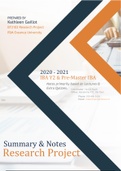Samenvatting
Research Project block 7 2021 Summary FULL slides/notes content compilation
- Instelling
- Erasmus Universiteit Rotterdam (EUR)
Contains all content from final block of the Research Project course. No information is left out, and I've added the occasional extra info or link to understand certain material. Tip: use the CTRL+F shortcut to locate keyword for easier navigation in the PDF. Priced lower as the recommended (non-m...
[Meer zien]




